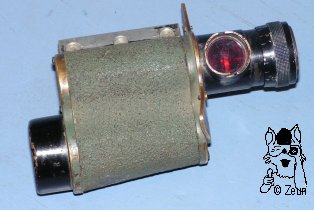
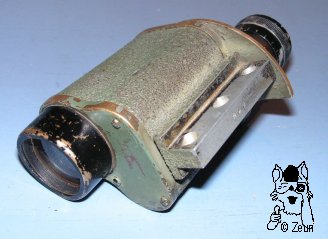
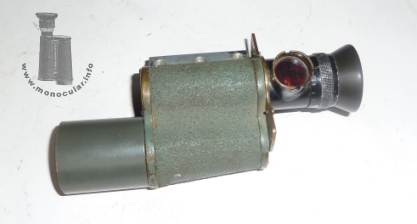

Fournier Visier mit drehende MikrometerBei dem "Viseur à Micrometre Tournant" (Viseur M.T.) handelt es sich um ein 6x27,5 Monokular mit eingebauter Strichplatte (s. Foto) und Vorrichtung zur Anbringung einer Strichplattenbeleuchtung (rotes Beleuchtungsfenster), welches von der Pariser Optikfirma "G. Fournier" hergestellt wurde. Das linksseitige Okularstück hat einen Dioptrienausgleich von plus 5 bis minus 5. Die Augenmuschel fehlt (konnte mittlerweile aber ersetzt werden). Das Okularstück lässt sich drehen, so dass anhand eines angeschraubten Zeigers am Okular und einer am oberen Deckel montierten halbkreisförmigen Messingplatte mit +/-90° Skala der Neigungswinkel beim Anvisiseren abgelesen werden kann. Zwei kleine Schräubchen am Rand der Platte verhindern, dass man das Okular um 360° drehen und somit heraus schrauben kann. Auf der Messingplatte ist auch der Firmenname eingraviert. (vgl. Colmont Visier)Das für den militärischen Gebrauch bestimmte Monokular stammt aus dem 1. Weltkrieg bzw. danach (1930er). Es wurde zur Zielkontrolle und -ausrichtung genutzt. |
Fournier Targeting or Gun-SightThis "Viseur à Micrometre Tournant" (Viseur M.T.) is a 6x27.5 monocular with a built-in reticle (s. photo) and a attachment tube for a reticle lighting (red window). It was made by the Paris optical producer "G. Fournier". The left-hand sided eyepiece has a +/-5 diopptre scale. The eyecup is missing, but could be substituted with another original one by now. The eyepiece can be turned so that you can read the degree of inclination by means of a pointer attached to the ocular tube and a brass semi-circular plate attached to the top cover. The plate is engraved with a scale ranging from +0 to 90° and -0 to 90°. Two small screws, one at each end of the rim of the plate, keep the eyepiece from turning in a 360° circle, and so cannot be unscrewed. The brass plate also bears the maker's name. (cf. Colmont sight)This military sight dates from WWI and afterards (1930s). It was used for target control and alignment. |




| Das Messinggehäuse ist mit einem körnigen graugrünem Strukturlack ummantelt. Auch die Deckel weisen diese Farbe auf, während der Objektivtubus schwarz lackiert ist. Der untere Deckel wurde per Hand mit einer roten römischen VII gekennzeichnet. Am Gehäuse ist ein Montageschiene angegossen. Diese weist drei Bohrungen zum Anbringen an einem Stativ auf. Die Montageschiene sowie die Innenseite des oberen Deckels sind mit "H63" markiert. Von einem anderen identischen, aber ungekennzeichnetem Eemplar stammt die aufschiebbare Sonnenblende. | The brass housing is painted with a granular greenish-grey textured lacquer. The covers also have this colour, whereeas the objective tube is painted black. The lower cover was once manually inscribed with a red Roman VII. There is a mounting rail at the body. It has three bore holes in order to attach the monocular to a tripod. The mounting rail as well as the inside of the top cover are marked with "H63". The slip-on sun-shade was added from another identical, but unmarked model. |
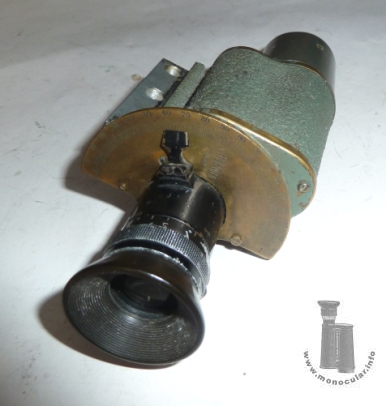
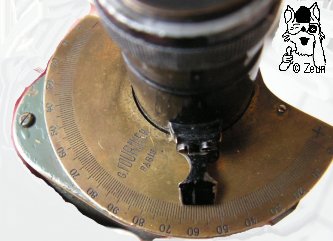
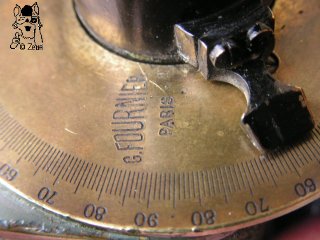
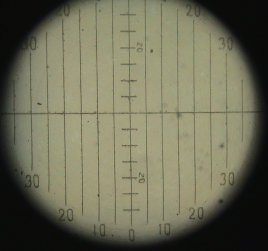
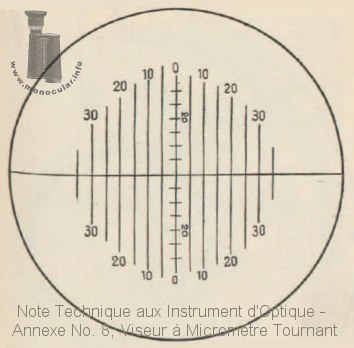
| Das Visiermonokular wiegt 349g. Es misst ca. 112mm in der Länge und 46x47mm oben bzw. 49x49mm unten am Gehäuse. Das Okular hat einen Durchmesser von 28mm, das Objektiv von 33mm. Die Montagestange ist ca. 18x15x57mm groß. Die halbrunde Messingplatte ist 68mm breit und 47,5 tief/hoch sowie 1,7mm dick. | This targeting monocular weighs 349g, measures ca. 112mm in length, and 46x47mm at the top and 49x49mm at the bottom of the housing. The eyepiece is 28mm, the objective frame 33mm in diameter. The mounting rod is about 18x15x57mm, the semi-circular brass plate is 68mm in width and 47.5mm long. It is 1.7mm thick. |
Fotos: Zeun